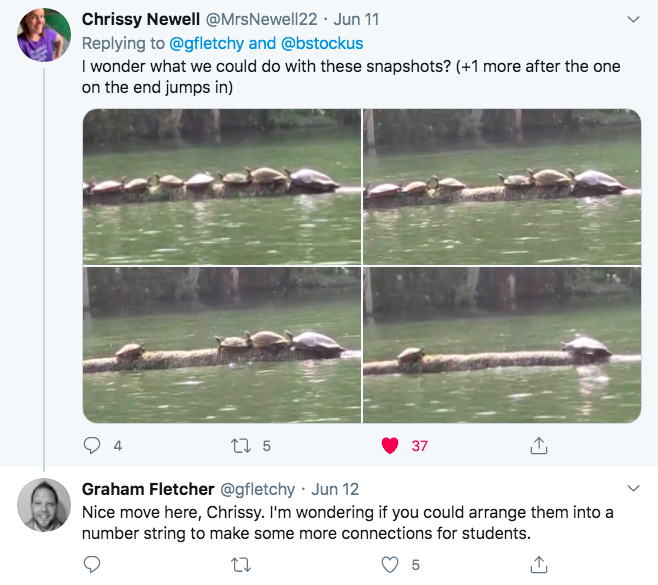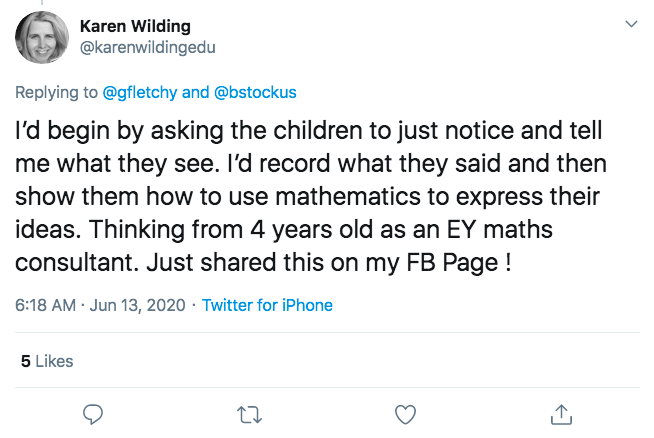I love checking Twitter daily to read about what’s happening in classrooms both locally and internationally regarding mathematics education. I find great new articles about mathematics research, see amazing tasks and engaged students, observe innovation in action, and collect ideas that I can use with young students as well as with in-service teachers and pre-service teachers I support. Last week Graham Fletcher (@gfletchy) shared a video that was ‘absolute gold’ sparking 60+ comments, 100+ retweets and 800+ likes, creating a collaborative lesson-designing thread like no other! When reading through the thread, it was like listening in to a group of amazing teachers in one room and writing a lesson plan together. So many wonderful ideas!
.@bstockus I’m wondering about creating a set of numberless word problems that match this context. Show this video first and then introduce students to the NL problems. Thoughts? pic.twitter.com/ag6qmoTZad
— Graham Fletcher (@gfletchy) June 10, 2020
I ‘liked’ the video straight away and thought I’d go back later in the week to comment as it was such a lovely video with so much mathematical potential. When I went back, it was wonderful to see so many other teachers and educator’s ideas and comments on how they would use the video in their classrooms. Graham was particularly interested in how to use the video as a base for a numberless word problem. Graham tagged Brain Bushart (@bstockus), Brian is a great sharer of his wonderful ideas, especially his work around numberless word problems. If you haven’t already, check out his blog here on numberless word problems, or this one, on advice on how to make your own. As mentioned by teachers in the turtle thread, and by Brian, numberless words problems (particularly ones that involve visuals) allow students to access the mathematics and think about problems in different ways instead of simply looking for numbers and ‘guessing’ what to do with them. They allow for teachers to orchestrate rich mathematical discussions where one absolute answer in not necessarily obvious and where students can almost ‘choose their own adventure’ with where the problem leads.
"Here's a picture after some of the turtles fell into the water. How many turtles fell in? How could we find out?" Solve, share, and then show the video. pic.twitter.com/xqNyTjZAUI
— Brian Bushart 🏳️🌈 (@bstockus) June 10, 2020
“… the purpose of a numberless word problem is to give students an opportunity to collaboratively identify and make sense of mathematical relationships in a situation before being presented with a question.”
Writing numberless word problems, Brian Bushart
“In essence, numberless word problems are designed to provide scaffolding that allows students the opportunity to develop a better understanding of the underlying structure of word problems.”
Numberless Word Problems, Brian Bashart
Within the thread, Brian gave a few suggestions. One of the first was this:
There are some turtles on a log.
Some fall off into the water.
There is a turtle left on the log.
This is a nice way to break the question down into smaller parts that students can have time to visualise and discuss at each point. Asking students what questions they have along the way helps to build the mathematical structure of the problem. As the teacher, predicting the types of questions students may have prior to the lesson is key to being able to ensure ‘intentional talk’ about the mathematics occurs. I would also add that representations of mathematics are essential in building conceptual knowledge. I would love for students to draw a picture or diagram for each sentence to show their thinking and discover what mathematics (if any) they perceive the statements relate to. The use of students’ representations is highlighted in much of Associate Professor Jenni Way’s (@Way8Jennifer) research. In her and Professor Janette Bobis’ (@janettebobis) paper Building connections between children’s representations and their conceptual development in mathematics, Way and Bobis state:
“… we highlight the importance of teacher intervention in helping make the mathematics inherent in student representations explicit, and of helping the children make connections between multiple representations of the same concept.”
Building Connections Between Children’s Representations and Their Conceptual Development in Mathematics (Way & Bobis, 2017, p. 70)
There were a number of other great ideas for how to use the video, one of which was Chrissy Newell’s (@MrsNewell22) idea of using snapshot images from the video that represent different aspects of the problem. Graham suggested using these to create a number string. You could also provide students with the story and ask them to put the images in order. You could give the images in order and ask students to write the mathematical story. You could give students the images in order and ask them to predict what happens next. In fact, showing the video and pausing it before the ‘climax’ would work like this as well, and reminds me of Day Meyer’s (@ddmeyer) way of using incomplete videos to ‘hook’ students into the mathematics.
Another lovely suggestion was by Karen Wilding (@karenwildingedu) who focused on the Noticing and Wondering start to using the video. Watching the video through and recording (orally) what students see is a great idea. Not only does this promote mathematical discourse but it also provides space for teachers to hear students fluency with numbers or mathematical concepts, listening out for the language they use – both mathematical terminology and general words. Karen mentions this would be a good way to use the the video for younger students, I agree and would add that it would be a good task for students in primary years as well, to notice how the language develops over time.
I recommend you go and read the thread if you haven’t already. Some great ideas are shared and the comments and thinking back and forth between teachers/educators is what collaboration at its best looks like. There was debate as to whether to show the video first to students or the story/problem. As discussed, there are pros and cons to both options. For students who may find the reading and comprehension of word-based problems just as difficult, or more difficult, than the numbers, showing the video first would be a good idea. This allows them to make their own ideas and assumptions and use their own words to describe it. Having the story text or prompt questions ready by the teacher means that the investigation of the problem is then student-led and the teacher only chimes in when necessary to steer the conversation. I would maybe even loop the video and just leave it playing during the lesson time and allow students to write about what they see and add it to a mathematics investigation board. They can then choose whether they write about it in words, or use numerals or symbolic representations. They may also want to use drawings or diagrams as well. Whatever you choose to do with the video, there are plenty of ideas. What a wonderful source of free professional learning social media outlets like Twitter can be. Thanks to everyone who shared their ideas on Graham’s post.
References
Bobis, J., Way, J. (2018). Building connections between children’s representations and their conceptual development in mathematics. In V. Kinnear, M. Y. Lai, T. Muir (Eds.), Forging connections in early mathematics teaching and learning, (pp. 55-72). Singapore: Springer.







